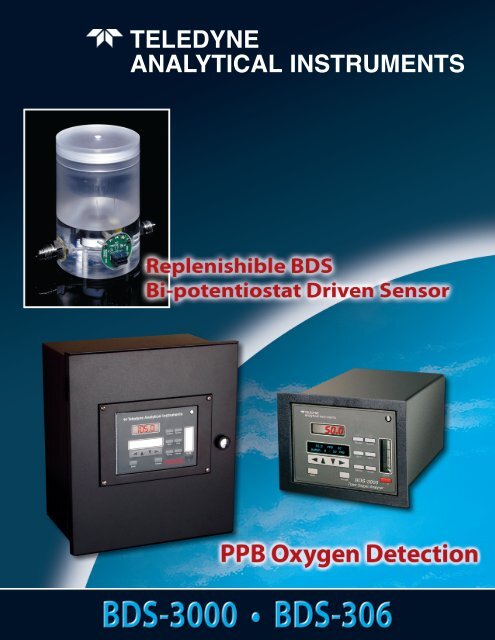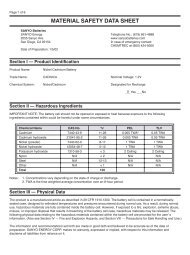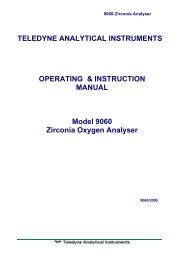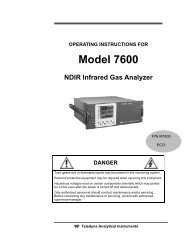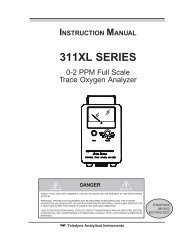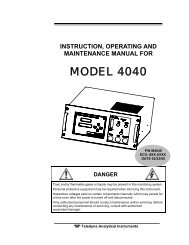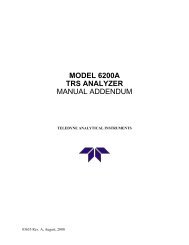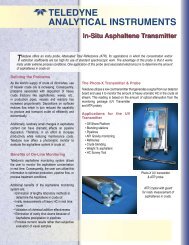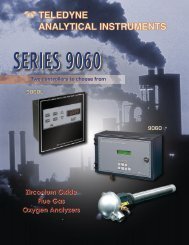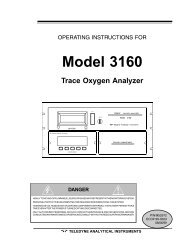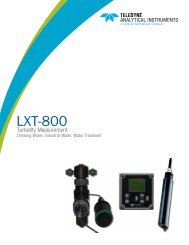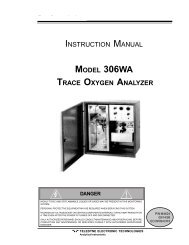Download the brochure - Teledyne Analytical Instruments
Download the brochure - Teledyne Analytical Instruments
Download the brochure - Teledyne Analytical Instruments
You also want an ePaper? Increase the reach of your titles
YUMPU automatically turns print PDFs into web optimized ePapers that Google loves.
TELEDYNE<br />
ANALYTICAL INSTRUMENTS
As <strong>the</strong> density of wafers produced within a semiconductor facility increases, so does <strong>the</strong> stringent requirement to accurately monitor for oxygen<br />
contamination at or below parts-per-billion (ppb) levels.<br />
Oxygen contamination is routinely monitored in <strong>the</strong> ultra-high purity (UHP) bulk gases such as nitrogen, argon, helium and hydrogen, which are<br />
used as blanket or carrier gases during <strong>the</strong> vapor deposition, sputtering and annealing processes. The ingress of oxygen at any point during <strong>the</strong><br />
wafer fabrication process will have a detrimental effect on product yields. Therefore, it is imperative for semiconductor manufacturers to prevent<br />
oxygen contamination problems caused by corroded valves, cylinder leaks or improperly mated fittings (at <strong>the</strong> process or tool level) as well as<br />
potential atmospheric oxygen leakage in load-locks or various o<strong>the</strong>r processing chambers.<br />
In response, TAI offers a high sensitivity Bi-potentiostat Driven Sensor (BDS). The replenishable BDS is a culmination of an extensive R&D effort<br />
within <strong>Teledyne</strong> in conjunction with several beta tests conducted with key <strong>Teledyne</strong> users in <strong>the</strong> semiconductor industry. The BDS achieves greater<br />
sensitivity (LDL of 500 ppt), faster response / recovery, and ease-of-use over any previous wet-cell oxygen sensor offering from <strong>Teledyne</strong>.<br />
THEORY OF OPERATION<br />
The BDS is constructed as a four electrode, non-depleting<br />
electrochemical cell driven by a bi-potentiostat circuit. The four<br />
electrodes, all located within <strong>the</strong> natural ABS sensor body and seethrough<br />
acrylic cap, are referred to as:<br />
• Sensing or "working" electrode<br />
• Protective electrode<br />
• Reference electrode<br />
• Counter electrode<br />
A potentiostat is an electronic circuit designed to control <strong>the</strong> potential<br />
of a "working" electrode. A Bi-potentiostat is an electrochemical<br />
system in which two working electrodes are under potential control. In<br />
<strong>the</strong> BDS design, <strong>the</strong> reference electrode provides a precise potential<br />
reference for both <strong>the</strong> sensing and protective electrodes. There is no<br />
pure electrochemical reaction at <strong>the</strong> reference electrode since <strong>the</strong><br />
electronic circuit prevents current flowing through this electrode.<br />
The sensing electrode (gas diffusion type) detects <strong>the</strong> oxygen found<br />
in <strong>the</strong> sample gas. The electrochemical reaction on <strong>the</strong> sensing<br />
electrode is <strong>the</strong> reduction of oxygen from <strong>the</strong> sample gas to form<br />
hydroxyl anions in <strong>the</strong> electrolyte. The counter electrode, where <strong>the</strong><br />
hydroxyl anions from <strong>the</strong> electrolyte are oxidized back to oxygen,<br />
provides <strong>the</strong> current path for <strong>the</strong> sensing electrode.<br />
In order to achieve a fast recovery from air to ppb oxygen levels, and<br />
to allow <strong>the</strong> sensor to operate in an open-to-air fashion, a second<br />
working electrode (i.e. <strong>the</strong> protective electrode) is incorporated into<br />
<strong>the</strong> sensor design. The protective electrode, made from Reticulated<br />
Vitreous Carbon (RCV), effectively removes any dissolved oxygen<br />
from <strong>the</strong> electrolyte in <strong>the</strong> vicinity of <strong>the</strong> sensing electrode while<br />
allowing hydroxyl anions to move through freely.<br />
Since <strong>the</strong> only electrochemical reactions inside <strong>the</strong> BDS are <strong>the</strong><br />
oxygen reduction to hydroxyl anion (at <strong>the</strong> sensing and blocking<br />
electrodes), and <strong>the</strong> conversion back to oxygen at <strong>the</strong> counter<br />
electrode, it is a non-depleting system.<br />
Sensing Electrode Reaction: O2 + 2H2O + 4e- ‡ 4 OH-<br />
Counter Electrode Reaction: 4OH- ‡ 4e- + 2H2O + O2<br />
Also, because a potential gradient is established between <strong>the</strong> lower<br />
part of <strong>the</strong> sensor (sensing and blocking electrodes) and <strong>the</strong> top<br />
part of <strong>the</strong> sensor (counter electrode), <strong>the</strong> BDS can also be used in<br />
applications where limited amounts of acid gases (i.e. CO2) may be<br />
present.<br />
Counter<br />
electrode<br />
Reference<br />
electrode<br />
Sensing<br />
electrode<br />
Gas outlet<br />
Electrolyte<br />
Baffle<br />
Figure 1. Potentiostat driven oxygen sensor<br />
Protective<br />
electrode<br />
Gas inlet<br />
The detailed construction and sample gas flow through <strong>the</strong> sensor is<br />
shown in Figure 1.<br />
The BDS design is superior to existing wet-cell oxygen sensors as<br />
<strong>the</strong> bi-potentiostat clearly controls <strong>the</strong> electrode potential much more<br />
precisely than conventional means. This enhanced design also provides<br />
<strong>the</strong> user with a sensor that is faster to respond to oxygen concentration<br />
changes and one that is unaffected if left exposed to zero gas for<br />
extended periods of time (i.e. no "sleep effects").<br />
The BDS sensor has a two-year warranty with an expected life of three<br />
to five years when used properly. There are no pro-rated warranty issues<br />
to be concerned with and <strong>the</strong> sensor replacement cost, when and if<br />
it must occur, is a fraction of o<strong>the</strong>r ppb wet cell sensing technologies<br />
currently available on <strong>the</strong> market.
SENSOR BAFFLE MECHANISM<br />
<strong>Teledyne</strong>'s unique, patent-applied-for mechanism within <strong>the</strong><br />
BDS sensor minimizes sensor downtime when water is added.<br />
Wet cells (replenishable sensors) generally suffer from oxygen<br />
reading upset when water is added to replace <strong>the</strong> amount lost to<br />
evaporation. Adding water to this class of sensor upsets <strong>the</strong> delicate<br />
electrochemical balance in <strong>the</strong> cell necessary to accurately analyze<br />
parts-per-billion of oxygen.<br />
Only <strong>Teledyne</strong> has solved this problem with a unique enhancement<br />
that radically slows <strong>the</strong> mixing of new water with <strong>the</strong> KOH solution<br />
already in <strong>the</strong> sensor. The concept is simple. A circular disk is<br />
inserted in <strong>the</strong> top of <strong>the</strong> cell. The disk has holes that allow for <strong>the</strong><br />
passage of water, but at a greatly reduced rate to lessen <strong>the</strong> upset<br />
of existing water and KOH. This is comparable to adding cream to<br />
coffee. When added quickly, clouds of cream billow up inside <strong>the</strong><br />
coffee cup. With a baffle system, adding cream would not create<br />
clouds but ra<strong>the</strong>r trap <strong>the</strong> cream on top where it would <strong>the</strong>n slowly<br />
mix with <strong>the</strong> coffee.<br />
ANALYZER INTERFACE<br />
The <strong>Teledyne</strong> Bi-potentiostat Driven Oxygen Sensor is available in two<br />
configurations:<br />
BDS-3000 | BDS-306<br />
BDS-3000<br />
The BDS-3000 provides <strong>the</strong> user with a compact, cost-effective<br />
means of reliably detecting ppb levels of oxygen for ei<strong>the</strong>r on-line<br />
or mobile-cart type applications for point-to-point gas-line tubing<br />
certification. By incorporating <strong>the</strong> BDS into <strong>the</strong> field proven Series<br />
3000 platform, we have been able to provide <strong>the</strong> operator with a wide<br />
variety of features and benefits:<br />
• Built-in isolation valves to lock off <strong>the</strong> sensor from atmospheric<br />
oxygen (when moving <strong>the</strong> unit from point-to-point)<br />
• Automatic sensor shutdown mode to protect <strong>the</strong> BDS in <strong>the</strong> event<br />
<strong>the</strong> sensor is inadvertently exposed to oxygen concentrations of 30<br />
ppm or higher. The analyzer will restart in 60 seconds from initial<br />
high oxygen detection and retry three times before user intervention<br />
is required.<br />
• Three user-programmable ranges which can be tailored to <strong>the</strong><br />
application needs in ei<strong>the</strong>r a fixed or auto-ranging analysis mode<br />
• Auto-calibration software<br />
• RS-232C bi-directional serial interface as well as 4-20 mA and 0-1<br />
VDC concentration output signals<br />
• Self-diagnostics and system failure alarm along with 2x fully<br />
adjustable concentration alarm set points<br />
• For low inlet sample pressure furnace-type applications, <strong>the</strong> BDS-<br />
3000 can also be fitted with an integral sample pump to draw <strong>the</strong><br />
sample gas to <strong>the</strong> BDS for continuous analysis<br />
<strong>Teledyne</strong> can also provide <strong>the</strong> BDS 3000 in a single 19" rack mount<br />
design or mount two BDS-3000s side-by-side in a single 19" rack<br />
panel, space-saving configuration.<br />
The BDS-306 was specifically designed to allow for current Model<br />
306WAM / Model 366 Open Cathode PPB / PPM Analyzer users<br />
to conveniently replace <strong>the</strong>ir existing units with a higher sensitivity<br />
drop-in replacement. The BDS sensor is mated with <strong>the</strong> Series 3000<br />
electronics / software in <strong>the</strong> familiar 306 panel-mount enclosure to<br />
facilitate <strong>the</strong> upgrade<br />
to <strong>the</strong> next generation<br />
design without having<br />
BDS-306<br />
to redesign <strong>the</strong> user’s<br />
existing panel.<br />
LEAK-FREE<br />
INTEGRITY<br />
The ultra-clean<br />
sample systems found<br />
in each design have<br />
been constructed<br />
using techniques<br />
and components<br />
that meet <strong>the</strong> quality<br />
requirements for high<br />
purity gas monitoring<br />
in <strong>the</strong> semiconductor industry. Electropolished 316L stainless steel<br />
tubing, VCR fittings, leak-proof, bead-and-crevice-free orbital welds<br />
with a minimal design of dead space volume and air-actuated metal<br />
bellows valves which eliminate <strong>the</strong> possibility of gas absorption. The<br />
BDS-3000, BDS-3960, and BDS-306 sample systems are all helium<br />
leak checked to 10-9 atm cc / sec to insure against atmospheric leaks<br />
prior to qualification.
BDS SERIES OF PPB OXYGEN ANALYZERS<br />
SPECIFICATIONS<br />
Ranges:<br />
Default ranges:<br />
Three user programmable ranges<br />
0-50 ppb, 0-1000 ppb, 0-10 ppm plus Overrange<br />
of 0-100 ppm<br />
Over-range is not user programmable<br />
Auto-calibration software:<br />
Standard; <strong>the</strong> frequency of <strong>the</strong> autocalibration<br />
cycles is user programmable.<br />
Dimensions: BDS-3000: 7" H x 8.75" W x 12.25" D<br />
BDS-306:<br />
17.0" H x 15.0" W x 10.0" D<br />
Accuracy:<br />
Detection method:<br />
Operating temp range: 5 to 40° C<br />
Lower detection limit:<br />
Response time:<br />
Resolution:<br />
Outputs:<br />
±2% of full scale at constant temperature<br />
±5% of full scale over entire operating<br />
temperature range<br />
Bi-potentiostat Driven Sensor (BDS)<br />
Technology (replenishable, non-depleting<br />
type)<br />
500 ppt<br />
90% in less than 60 seconds<br />
0.1 ppb<br />
4-20 mADC isolated percent of range output<br />
0-1 VDC percent of range output and range<br />
ID output<br />
SENSOR FEATURES<br />
• Bi-potentiostat driven, 4-electrode non-depleting sensor<br />
• Precise control of potential voltages delivered to <strong>the</strong> sensor<br />
electrodes ensuring high accuracy<br />
• Simple-to-use, long-life, low-cost sensor design<br />
• No sensor temperature control requirements<br />
• Quick response to changes in O2, even after extensive<br />
exposure to oxygen-free sample or zero gas streams (i.e. no<br />
sensor "sleep" effects)<br />
• Baffle mechanism in sensor lessens downtime<br />
Contacts:<br />
2 x fully programmable concentration alarms,<br />
1C contacts, 250 VAC, 3A resistive<br />
System failure alarm, power failure or<br />
calibration failure, 1C contacts, 250 VAC, 3A<br />
calibration contact, 1A, 250 VAC, 3A resistive<br />
Four Range ID contacts, 1A, 250 VAC 3A<br />
resistive<br />
Serial interface:<br />
Power requirements:<br />
Bi-directional RS-232 for output,<br />
concentration, ranges and alarm information<br />
(fed every two seconds). Accepts zero and<br />
span commands through RS-232<br />
100 VAC to 240 VAC, 50 / 60 Hz<br />
Sensor warranty: Two years (expected life of 5 years +)<br />
TELEDYNE<br />
ANALYTICAL INSTRUMENTS<br />
A <strong>Teledyne</strong> Technologies Company<br />
16830 Chestnut Street<br />
City of Industry, California 91748, USA<br />
Warranty<br />
Instrument is warranted for 1 year against defects in material<br />
or workmanship<br />
NOTE: Specifications and features will vary with application. The above are established<br />
and validated during design, but are not to be construed as test criteria for every product.<br />
All specifications and features are subject to change without notice.<br />
TEL: 626-934-1500 or 888-789-8168<br />
FAX: 626-934-1651 EMAIL: ask_tai@teledyne.com<br />
www.teledyne-ai.com<br />
© 2006 <strong>Teledyne</strong> <strong>Analytical</strong> <strong>Instruments</strong>, A <strong>Teledyne</strong> Technologies Company.<br />
All rights reserved. Printed in <strong>the</strong> USA.<br />
09/06LD


